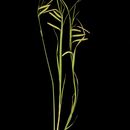Comments
provided by eFloras
The status of Carex crinita var. porteri (Olney) Fernald [C. porteri Olney], a rare, long-beaked taxon known from two sites in Somerset and Lincoln counties, Maine, is in question and is not treated here. It has not been collected since around the early 1900s.
- license
- cc-by-nc-sa-3.0
- copyright
- Missouri Botanical Garden, 4344 Shaw Boulevard, St. Louis, MO, 63110 USA
Description
provided by eFloras
Plants cespitose. Culms acutely angled, 40–150 cm, scabrous. Leaves: basal sheaths red-brown or brown; sheaths of proximal leaves bladeless, glabrous, fronts red-brown to copper-brown, spots absent, indistinctly ladder-fibrillose, apex U-shaped; blades hypostomic, abaxially papillose. Proximal bract longer than inflorescence, 3–6 mm wide. Spikes usually pendent; staminate 1–3, base cuneate or attenuate. Pistillate scales pale to copper-brown, midvein reaching apex, broad, apex of body retuse, aristate. Perigynia divergent, pale brown, inflated, loosely enclosing achenes, obovoid, dull, apex rounded, obtuse or truncate, glabrous. Achenes constricted on one or both margins or lacking constrictions; style base straight.
- license
- cc-by-nc-sa-3.0
- copyright
- Missouri Botanical Garden, 4344 Shaw Boulevard, St. Louis, MO, 63110 USA
Comprehensive Description
provided by North American Flora
Carex crinita Lam. Encyc. 3: 393. 1791
Carex leonura Wahl. Sv. Vet.-Akad. Nya Handl. 24: 161. 1803.
Carex crinita var. paleacea Dewey, Am. Jour. Sci. 10: 270. 1826. (As to plant described.)
Diemisa crinita Raf. Good Book 27. 1840. (Based on Carex crinita Lam.) (Type from Pennsylvania.)
Neskiza crinita Raf. Good Book 27. 1840. (Based on Carex crinita Lam.)
Carex crinita var. morbida Carey, Am. Jour. Sci. II. 15: 24. 1853. (Type from the eastern United States.)
Carex crinita var. minor Boott, 111. Carex 18. 1858. (Sarlwell 78, from Penn Yan, New York, is taken as the type.)
Cespitose in large clumps, from stout rootstocks; the stolons very short, ascending, the culms 4-12 dm. high, erect, stout and thick at base (4-7 mm.), slender and weak above, exceeding the leaves, sharply triangular with concave sides and thickened angles, and from somewhat to strongly roughened, strongly aphyllopodic, brownish-red-tinged at base, the basal sheaths prominently keeled, breaking and usually prominently filamentose; sterile shoots aphyllopodic; leaves with well-developed blades 3-5 to a fertile culm, on the lower half but not bunched, noticeably septate-nodulose, the blades flat with revolute margins, firm, lightgreen, usually 1-4 dm. long, 3-10 mm. wide, strongly roughened towards apex; sterile-culm leaves longer; sheaths not hispidulous, smooth dorsally, very thin and brownish-yellow-tinged ventrally, prolonged upward beyond base of blade, the ligule much longer than wide; staminate spikes 1 or 2, on slender peduncles, often drooping, often partly pistillate, narrowly linear, often nexuous, 2-6 cm. long, 2-3 mm. wide, the scales usually linear-lanceolate and longacuminate or awned, but varying to oblong-obovate and obtuse, straw-colored or brownish with green center; pistillate spikes 2-6 (usually 3 or 4), approximate, drooping (or occasionally somewhat erect), on rough or sometimes smooth peduncles from about the length of to shorter than the spikes, the spikes narrowly cylindric, usually curving, 2.5-10 cm. long, 8-12 mm. wide, often short-staminate at apex, densely flowered, the perigynia very numerous, spreadingascending, or squarrose at maturity, in several to many rows; bracts leaf -like, sheathless or nearly so, the 2 or 3 lower exceeding culm, the upper reduced; scales with broadly obovate bodies, deeply retuse at apex, abruptly contracted into a long serrulate awn, ascendingspreading, somewhat narrower than and (including the awn) from 2 to 3 times the length (the lower) to little exceeding (the upper) the perigynia, the center of the bodies 3-ribbed, green, the remainder reddish or yellowish -brown ; perigynia obovoid, inflated and suborbicular in cross-section, little flattened and 2-edged, nerveless or faintly nerved, 2-3.5 mm. long, 1.25-2 mm. wide, membranaceous, puncticulate, smooth or nearly so, greenish or straw-colored, rounded or round-truncate at base, slenderly substipitate, rounded or round-tapering and abruptly minutely apiculate at apex; the beak 0.25 mm. long with entire orifice; achenes lenticular, loosely enveloped in lower two thirds of perigynium, nearly sessile, oblong-ovoid, 1.5 mm. long, 1.25 mm. wide, brownish, usually strongly constricted in the middle, obscurely jointed with the slender bent style, the latter thickened towards base, stigmas 2, rather short.
Type locality: " Cette plante croit dans la Virginie."
Distribution: Swampy swales and woods, Quebec and Nova Scotia to Minnesota, and southward to North Carolina and Texas. (Specimens examined from Quebec, Nova Scotia, Prince Edward Island, New Brunswick, Maine, New Hampshire, Vermont, Massachusetts, Rhode Island, Connecticut, New York, New Jersey, Pennsylvania, Delaware, Maryland, District of Columbia, Virginia, North Carolina, Ontario, Michigan, Wisconsin, Ohio, Indiana, Minnesota, Kentucky, Tennessee, Missouri, Arkansas, Louisiana, Texas.)
- bibliographic citation
- Kenneth Kent Mackenzie. 1935. (POALES); CYPERACEAE; CARICEAE. North American flora. vol 18(7). New York Botanical Garden, New York, NY

